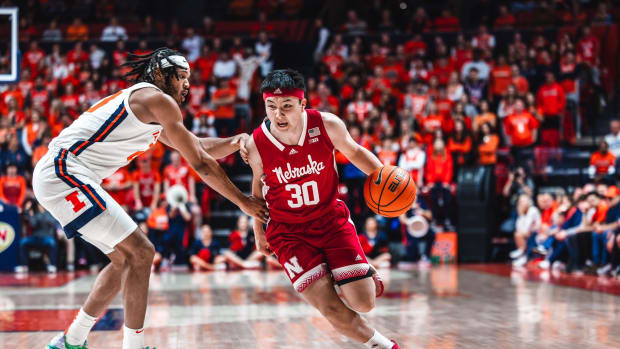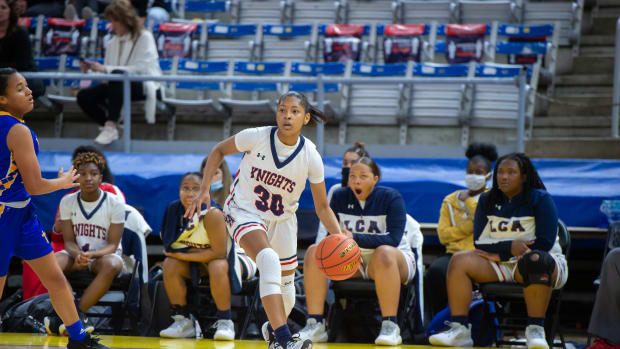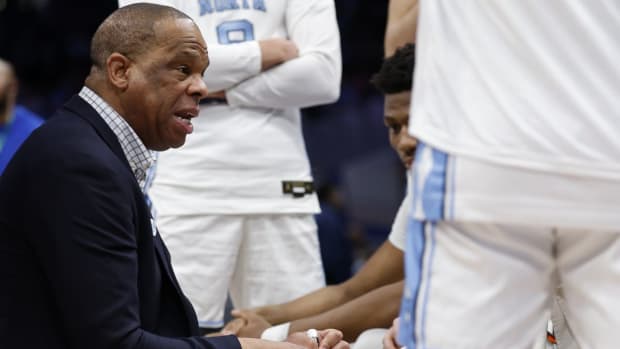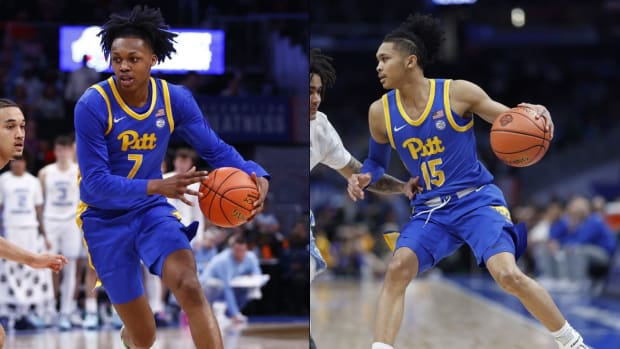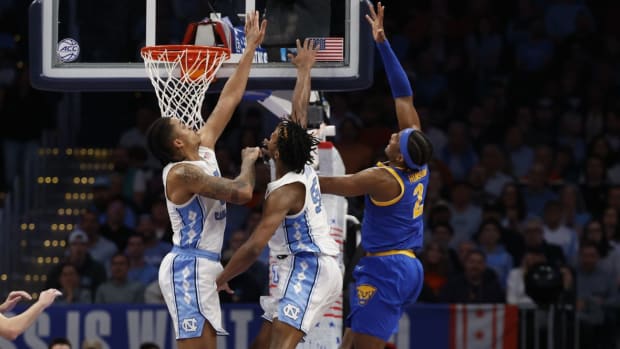Hoop Thoughts: Which team's luck will run out in Final Four?
And then there were Four.
I have often said, in quoting a former Connecticut high school coach named Gary Palladino, that basketball is 70% talent, 20% coaching and 10% luck. For the NCAA tournament, we might need to triple that luck quotient. This event was created to construct chaos. The ability to advance depends on whether you can be the right team with the right player getting hot—and lucky—at the right time.
So it goes without saying that all four of the remaining teams have enjoyed their fair share of luck to this point. As we head into the final weekend, the question we face is: Whose luck is about to run out? Or put in an eggheadish kind of way, which algorithmic aberration is destined to revert to the mean?
• Is your team in the Final Four? Get your gear right here!
I’m no math maven, but I play one on the Internet, so I dove into the numbers to discern the areas of outperformance through the first four rounds. That should help us figure out which Final Four teams are bound to keep their momentum going, and which ones are headed for a regression and with it, a season-ending loss.
North Carolina might be the most fortunate team in this Final Four
South Carolina
Area of outperformance: Offensive efficiency
Much attention has been given to the Gamecocks’ defensive prowess, and rightly so, but they have only been doing what they did all season. South Carolina is ranked No. 2 in the nation in defensive efficiency, per KenPom. Moreover, its defensive field goal percentage numbers in the tournament are exactly where they were during the regular season. The Gamecocks are allowing teams to score four more points per game, which is largely a result of a quicker pace as well as much better free throw shooting by opponents (84.4% in the tourney versus 71.1%). So it comes as no surprise that South Carolina has been playing lockdown defense the last four games.
South Carolina in the Final Four, though? That is a surprise. And it came about because this team has been able to score at a much better clip. Entering the tournament, the Gamecocks were scoring 1.019 points per possession. In the tournament, they are scoring 1.161 points per possession. Before the tournament, they scored 72.1 points per game while shooting 41.4% from the field. In their four tournament games, they are averaging 82 points while shooting 47.6% from the field.
How Sindarius Thornwell and South Carolina 'secured the bag' to advance to the Final Four
And while their three-point percentage is slightly down from where it was in the regular season, their foul shooting has skyrocketed from 69% to 75.2%. Sophomore forward Chris Silva, who was making 73% from the line, has made 24 of his 29 free throw attempts in the tourney. Moreover, while the Gamecocks shot on average one fewer free throw per game before the tourney began, they are averaging seven more free throws per game than opponents over the last four games. Some of that stemmed from playing with a lead down the stretch while the other team was fouling, but there is no doubt that the Gamecocks are cashing in from the stripe much more efficiently than they did all season. That has been a huge difference.
Not surprisingly, the field goal percentages are greatest amongst South Carolina’s three leading scorers—Sindarius Thornwell, P.J. Dozier and Silva. Yes, those guys play defense like their lives depend on it. But they’re still alive because of the way they’ve been scoring.
• GREENE: Chris Silva's journey from novice in Gabon to key piece for Gamecocks
What this means for the Final Four: How remarkable was South Carolina’s second-half, 65-point blitzkrieg against Duke? This team played 10 games this season without scoring that many points. Keep in mind that the Gamecocks ended their season losing five out of seven games, including by 11 points to Alabama in the SEC tournament. In those five losses, they shot a combined 28 for 123—or 22.8%—from three. I’m not saying they will be that bad Saturday, but I am saying that all of this gives us reason to doubt that they can be as good on offense as they’ve been the last two weeks. Mathematically, it’s unlikely.
Gonzaga
Area of outperformance: Defensive efficiency
Raise your hand if you knew the Zags were ranked No. 1 in the country on KenPom in defensive efficiency this season. We tend to view this program as built on finesse and skill, but Gonzaga showed its mettle in winning these last four games. That was especially important given how poorly the Zags have played on offense. I don’t know if it’s nerves, bad luck or that they’re facing good defenses (probably all three), but Gonzaga has had to rely on locking down opponents more than ever before.
The numbers bear this out. Coming into the tournament, Gonzaga was holding opponents to 0.863 points per possession. In the tournament, opponents are scoring 0.84 points per possession. Pre-tourney, Gonzaga’s opponents shot 36.8% from the field, 30% from three and scored 61.2 points per game. In the tourney, opponents are shooting 33.7% from the field, 24.1% from three and scoring 59 points per game.
The Breakthrough: Its Cinderella days long behind it, Gonzaga at last reaches Final Four
As I said, this has become necessary because the Zags have not been as crisp at the offensive end. Their field goal percentage has dipped from 51.8 to 43.2; their three-point shooting from 38.2 to 35; and their foul shooting from 73.8 to 58.6.
Individually, no Gonzaga player has underperformed on offense more than leading scorer Nigel Williams-Goss, a 6' 3" junior point guard. He went from shooting 52%, 37% and 91% during the season to 31%, 33% and 73% in the tourney. The good news is Williams-Goss got better with each game, culminating with a more typical performance in the Elite Eight win over Xavier, when he had 23 points on 4 for 7 shooting from three-point range (though he was still 3 for 12 on two-point field goals).
• BELLER: Final Four breakdown: Matchups to watch in each semifinal
What this means for the Final Four: Gonzaga does not wear the favorite crown well. These guys knew full well that there were many people who doubted whether their record was fraudulent because they play in a weaker conference. And there is much validity to the assessment that playing in the WCC does not prepare a team well for the rigors of March. Having survived all of that and broken through to their first Final Four, I believe the Zags are ready to relax and play their game. They’ve been playing terrific defense all season. I believe they’ll be making a lot more shots in Phoenix.
North Carolina
Area of outperformance: Maye Day
He was supposed to come to Chapel Hill as a walk-on, but Luke Maye played his way into NCAA tournament lore in Memphis, scoring 17 points against Kentucky, including the dramatic game-winner with 0.3 seconds left, to deliver the Tar Heels to the Final Four. Maye also had 16 points off the bench in UNC’s Sweet 16 win over Butler, and in the two games he made 5 of his 8 three-point attempts. That’s almost half of the 11 three-pointers Maye converted all season. He also grabbed 12 rebounds against Butler, even though he averaged fewer than four per game coming into the tournament.
Sometimes a player can catch lightning in a bottle, but Maye strikes me as a really good player who was able to make the most of an opportunity when it was finally afforded to him. It would be one thing if Maye had been getting extended court time all season, but he only averaged 13.8 minutes coming into the tournament. His shooting percentages pre-tourney (48% overall, 39% from three) indicate that he was always likely to score if he got more minutes. Still, there was no way to predict that a guy who was the team’s eighth-leading scorer (4.9 ppg) during the season would be the second-leading scorer (12.5) and be named the Most Outstanding Player in the South Regional. So that was quite lucky.
UNC’s Luke Maye etches his name in tournament lore with shot to beat Kentucky
It’s safe to say that without this injection of scoring from such an unlikely source, the Tar Heels would probably not be in the Final Four. Junior point guard Joel Berry, who has been hobbled by a sprained ankle, has shot just 6 for 26 from three over the last four games, compared to 41.8% coming into the tournament.
Besides Maye’s surprising productivity, the Tar Heels have really defended the three-point line well. During the season, opponents shot 34.3% against the Heels from three. In the tournament, they’ve shot 31.6%.
What this means for the Final Four: This is just a hunch, but I believe Maye is going to be a significant factor in Phoenix, especially if Berry isn’t 100%. Just when you thought a team couldn’t get any deeper, it did—and at the perfect time.
Oregon
Area of outperformance: T.D.
I speak, of course, of Tyler Dorsey, the Ducks’ 6' 4" sophomore guard who has been out of his gourd these last two weeks. Dorsey was a fine player during the regular season, when he ranked second on the team in scoring with 13.3 points per game while draining 44% from the field and 39% from three-point range. Heading into the month of March, Dorsey had passed the 20-point mark four times. Two of those came in home wins against Army and Savannah State.
The inside story of how Oregon reached the Final Four despite Chris Boucher's injury
Now, however, Dorsey has passed that mark in seven consecutive games. During the NCAA tournament, he is averaging 24.5 points per game while shooting 67% from the field and 65% (17 for 26) from three. He also hit Oregon’s two biggest shots of the tournament: a three-pointer with 40 seconds remaining to break a 72-all tie in the second round against Rhode Island and another late-shot-clock three with 1:50 to go against Kansas, which pushed the Ducks’ lead back to nine just when the Jayhawks appeared to be mounting a comeback.
It is no coincidence that five of those seven 20-point games have come after the Ducks’ backup forward, Chris Boucher, was lost for the season with a torn ACL. Though Boucher was an important piece in the Ducks’ success (he brought that rarest of combinations, a shot blocker/three-point shooter), the truth is that he had long ago ceded his starting spot to Jordan Bell, the 6' 9" man-child whose dominating defense and offensive rebounding was critical during the regional games in Kansas City. Oregon’s rotation may have gotten a little tighter after Boucher went out, but that has also meant more minutes for Bell and more shots for Dorsey. I’d say that worked out pretty well.
What this means for the Final Four: This may appear similar to the situation with Luke Maye, but it isn’t. Maye is taking advantage of opportunities he didn’t get during the regular season. Dorsey, on the other hand, started every game for the Ducks, and though his minutes are up in the wake of Boucher’s injury (34.8 per game in the tournament versus 29.2 in the regular season), there is no way to explain his shooting in this tournament other than saying this is a really good player with a really hot hand. He is bound to cool off sometime ... isn’t he?
